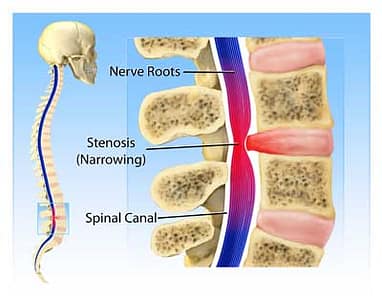 DEAR MAYO CLINIC: I was diagnosed with spinal stenosis about 12 years ago. I haven’t had many symptoms over the years, but about six months ago I started noticing increasing discomfort in my legs. Is surgery an option to treat spinal stenosis? If not, what else can I do? The leg pain is making it hard for me to walk.
DEAR MAYO CLINIC: I was diagnosed with spinal stenosis about 12 years ago. I haven’t had many symptoms over the years, but about six months ago I started noticing increasing discomfort in my legs. Is surgery an option to treat spinal stenosis? If not, what else can I do? The leg pain is making it hard for me to walk.
ANSWER: Surgery usually isn’t necessary to treat spinal stenosis. Often a combination of lifestyle changes, physical therapy and medication can effectively decrease the pain and discomfort caused by this common back problem.
Spinal stenosis occurs when the open space within your spine narrows, causing pressure and irritation to the nerve tissue. It can happen for a variety of reasons, but most of the time spinal stenosis is a result of aging and the buildup of arthritis. In some cases, spinal stenosis does not cause any symptoms and may be found during a medical test done for another reason.
Spinal stenosis, and the nerve compression that is associated with it, tends to develop slowly. Over time, it can put pressure on your spinal cord and the nerves that travel through the spine to your arms and legs and possibly cause symptoms.
If the nerves affected are in your neck — the part of your spine called the cervical spine — that may cause numbness, weakness or tingling in an arm or hand, or trouble with coordination in a leg or foot. It often causes problems with walking and balance. Nerves to your bladder or bowel can be affected too.
When spinal stenosis affects nerves in your lower back, called the lumbar spine, that may lead to pain or cramping in your legs when you stand for a long time, or back discomfort when you stand up and when you walk. The discomfort usually eases when you bend forward or sit down.
When spinal stenosis causes symptoms that interfere with daily activities, treatment usually begins with self-care steps. For example, people with mild symptoms often benefit from changes to their diet and nutrition. A healthy weight loss can take some stress off the back, particularly the lumbar portion of the spine.
By Dr. Paul Huddleston, orthopedic surgery, Mayo Clinic, Rochester, Minn.
10/01/2015
Continue reading the full article from Los Angeles Times here
 Skip to content
Skip to content
